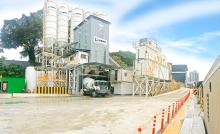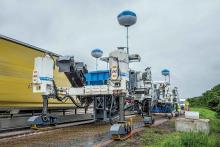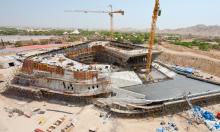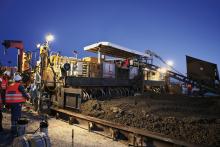
Concrete is being used for the construction of two major projects in Africa and Asia.
After water, concrete is the most used substance in the world. Whether it is employed in the construction of one of the few concrete roads in Africa or one of Asia’s tallest structures, the material is also among the most flexible.
Nigeria’s Kogi State now has a new 24km road, which is notable as it is now the country’s longest road to be made from concrete, and it could well set a precedent for road construction in the country.
Nigeria has a high level of seasonal rainfall, which can result in rapid wear and tear for asphalt roads. Overloaded vehicles further increase wear rates.
But concrete roads may cope better with the rainfall, which can result in large volumes of water being deposited in a small area in a comparatively short period of time. They may also provide greater resistance to the overloading.
Built in a joint venture partnership between Nigerian company
Dangote says that it opted to use a
With a cement facility close at hand, the company says it was able to monitor and maintain concrete quality to the necessary specifications and ensure a homogenous mix was supplied to the paver. Monitoring the paver’s operation also ensured that the necessary road profile could be achieved, says Dangote.
Construction work for the road took six months, with the road lying on a base comprising a compacted laterite filling and 150mm crushed stone.
The road has been constructed on top of this base structure, using the Wirtgen SP 500 slipformer to pave the lanes in each direction of travel. This required the construction of 3.65m wide by 200mm thick slabs in either direction, featuring 12mm diameter tie bars.
The project used around 35,000m³ of concrete, with four mixer trucks initially being used to carry the material from the plant to the slipformer and up to 15 in operation as the construction project reached its peak.
According to Dangote, it expects the road to have a longer operating life than a comparable asphalt surface, with well-maintained concrete pavements having a lifespan of 40 years.
Nigeria’s road authorities will be monitoring the performance of this section of road to see whether a concrete structure is suitable for Nigeria’s challenging climate. Should performance meet expectations, more concrete roads may well be built in Nigeria.
At the end of 2018, the 439m high Signature Tower will be a new architectural highlight gracing the skyline of Kuala Lumpur, Malaysia’s capital city, and will be one of the tallest structures, ranking among the world’s top 15.
The design of the Signature Tower was drafted by Mulia Group Architects, and the building tapers continuously as it rises. It is topped by a 48m high illuminated crown made of special glass.
Project owner of the new high-rise building is Indonesia’s Mulia Group, which has planned the 92-floor structure primarily as office space. There are no interior columns.
Lead contractor on this build is China State Construction Engineering Corporation, and
The core of the Signature Tower is made of reinforced concrete and the floor slabs are of steel-composite design.
Working closely with the high-rise specialists at the company’s headquarters in Amstetten, Austria, Doka Malaysia developed a practical formwork and safety concept adapted to the tight construction schedule and the customer’s high safety requirements.
“Mulia’s Signature Tower project is a fast-track super high-rise building, and as such we felt it was important to have a reliable partner on board with both international and local expertise. Doka’s climbing formwork system for the core, along with on-site instruction for formwork assembly and operator training, allow us to confidently cycle floor to floor at a rate of four days with the greatest efficiency and assurance of high quality”, says Corey Suckling, project engineer with Mulia Property Development.
“We have to stick to a four-day cycle, so everything has to be coordinated. The crew splits into parallel teams for working the formwork, placing the reinforcement, pouring the concrete and doing the various finishing jobs. The timing is all-important, says Andhi Irawan, senior sales manager, Doka Malaysia.









